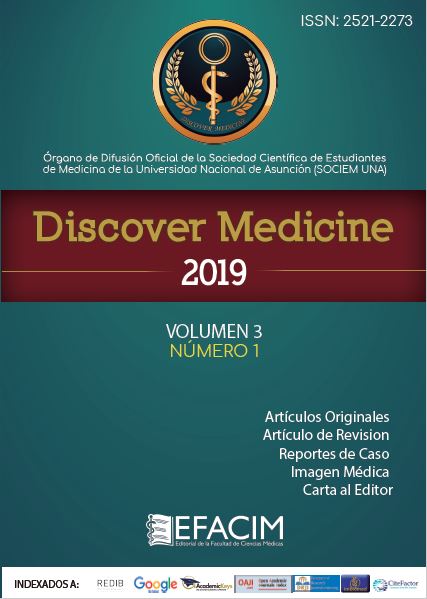Abstract
Background: In general terms the infectious diarrhea is a frequent entity and usually benign. But especially in weakened patients (kids, malnourished, immunosuppressed) the mortality has significance for the high morbidity. The objective of this work was to determine the prevalence of Salmonella spp, Shigella spp, Campylobacter spp and Rotavirus and besides describe the antibiotics resistance profiles.
Methods: Observational, descriptive and retrospective study. There were checked the results of the Microbiology Laboratory of the Clinic Hospital - Paraguay in the period 2014-2017. The samples analyzed in this time was 3615. In all the samples looked for
Salmonella spp, Shigella spp and Campylobacter spp, and in 235 samples Rotavirus.
Results: There were found 111 (3.07 %) enteropathogenic agents looked for in this work. Of all the studied samples were isolated 35 Shigella spp, 23 Salmonella spp and 25 Campylobacter spp. Regarding to Rotavirus, 28 (12%) tests were positive. With regard to the resistance profile of Shigella spp were found a high resistance to TET (66,7%), SXT (66,7%), CXM (61,11%). Salmonella spp presented a remarkable resistance to CEP (90%), TET (80%) and CXM (76,92%). Were found 20% of Campylobacter spp resistant to ciprofloxacina.
Conclusion: The most prevalent bacterium was Shigella spp (42,17%) and this agrees with other studies. Regarding to the antibiotic resistance of Salmonella spp a study that was done in Paraguay in the period 2011- 2012 found a high resistance to NAL (53%) and in this study all the samples were sensitive to this antibiotic. Worth noting that in this study was not found Campylobacter spp resistance to eritromicina and this is consistent with other reviewed studies
References
Who.int [Internet]. Ginebra: Organización Mundial de la Salud; Mayo 2017 [citado octubre 2017].Disponible en: http://www.who.int/mediacentre/factsheets/fs330/es/
Who.int [Internet]. Ginebra: Organización Mundial de la Salud; Septiembre 2017 [citado octubre 2017].Disponible en: http://www.who.int/mediacentre/factsheets/fs139/es/
Durango J, Arrieta G, Mattar S. Presencia de Salmonella spp. en un área del Caribe colombiano: un riesgo para la salud pública. Biomédica [Internet].2004 [citado en septiembre 2017]; 24(1). Disponible en:http://www.redalyc.org/articulo.oa?id=84324111
Alvarez FL , Copes J , Alvarez M , Nuñez L , Suzuki K , Goretti M , Zarate N , Castro L , Weiler N , Faccioli ML , Leotta G. Frecuencia de Salmonella entérica en aves de traspatio de la localidad de San Lorenzo, Departamento Central, República del Paraguay. Analecta Veterinaria[Internet]. 2010 [citado octubre 2017)
Canese A, CaneseA.Manual de MICROBIOLOGÍA y PARASITOLOGÍA MÉDICA. 7ma Edición. Paraguay: 2012.
R.S. Cotran, V. Kumar, T Collins. Robbins. Patología estructural y funcional. Mc Graw Hill-Interamericana, Madrid, 8va y 9na edición
Murray,P; Rosenthal,K;Pfaller,M; Di Francesco, P; Angiolella,
L. Microbiologia médica. 7ma Edición. Barcelona, España: ELSEVIER; 2014.
García C, Valenzuela S., Rodríguez L., León C. y Fernández J. Susceptibilidad antimicrobiana de Campylobacterjejuniaislado de coprocultivos en Santiago de Chile. SCIELO. [Internet ] 2009 [citado 26 oct 2016]; vol 26 (6): 2. Disponible en:http://www.scielo.cl/scielo.php?pid=S0716-10182009000700004&script=sci_arttext
Gutiérrez A., Castillo L., Paasch Martínez N., Calderón A. Salmonelosis y campilobacteriosis, las zoonosis emergentes de mayor expansión en el mundo[Internet ] 2008 [citado 26 oct 2016]; vol39 (1): 10. Disponible en:http://www.scielo.org.mx/scielo.php?pid=S0301-50922008000100007&script=sci_ arttext&tlng=pt
Salas C., Gil-Setas A., Mazón A. Etiología y sensibilidad antibiótica de las infecciones extrahospitalarias más frecuentesmundo [Internet ] 2006 [citado 26 oct 2016]; vol 29 (1):20. Disponible en:http://scielo.isciii.es/scielo.php?script=sci_arttext&pid=S1137-66272006000100003
Dr. Tamayo Meneses, Dr. Berti Moreno Lago. Rotavirus. Revistasbolibanas. [Internet] [citado 26 oct 2016]:1-2:. Disponible en:http://www.revistasbolivianas.org.bo/pdf/chc/v52n1/v52n1a17.pdf
Delpiano M., Riquelme R, Casado F. y Álvarez H.Comportamiento clínico y costos de la gastroenteritis por rotavirus en lactantes: Adquisición comunitaria versus nosocomial. [Internet ] 2006 [citado 26 oct 2016]; vol 23 (1): 5. Disponible en:http://www.scielo.cl/scielo.php?pid= s0716-10182006000100003&script=sci_arttext&tlng=en
García Saito, Viviana I.; Gariboglio Vázquez, María L.; Zaloff Dakoff, Ana M.; Álvarez Estigarribia, Mónica;. Sucin, Mónica G; Moreira, Gloria; Lösch, Liliana S.; Merino, Luis A. Prevalencia de bacterias enteropátogenas en niños que asisten a un hospital pediátrico en Resistencia, Chaco, Argentina. [ Internet ]. Revista de la Facultad de medicina del nordeste 2017 [citado en 28 oct 2017]; vol 37(1).
Rincón, G.1; Ginestre, M.; Harris, B.;Romero, S. y Martínez, A. Frecuencia de bacterias enteropatógenas en niñosmenores de cinco años. Kasmera [Internet]2002 [citado 26 oct 2016]:30(1): 33-41.
VILLACRÉS, Irina et al. Sensibilidad antimicrobiana y detección de genes de virulencia en aislados clínicos de Shigella spp.Revista Ecuatoriana de Medicina y Ciencias Biológicas, [S.l.], v. 36, n. 1-2, p. 67-76, ago. 2017. ISSN 2477-9148. Disponible en: <http://remcb-puce.edu.ec/index.php/remcb/article/view/266
Natalie Weiler, Maria Orrego, Mercedes Alvarez, Claudia Huber, Flavia Ortiz, Lorena Nuñez, Laura Piris, Jose Primeros resultados de la vigilancia integrada de la resistencia antimicrobiana de patógenos transmitidos por alimentos, Campylobacter spp. y Salmonella spp. en tres poblaciones distintas. Paraguay. 2011-2012 .Mem. Inst. Investig. Cienc. Salud. 2017; 15(2):64-.015(02)64-072
González-Hein G., Cordero N., García N. y Figueroa G. Análisis molecular de la resistencia a fluoroquinolonas y macrólidos en aislados de Campylobacter jejuni de humanos, bovinos y carne de ave [Internet]. 2013 [ 28 oct 2017]; vol 30 (2): 13 Disponible en: http://www.scielo.cl/scielo.php?pid=S0716-10182013000200003&script=sci_arttext
Hernández G., Santiago L., Reséndiz E., Narváez C., Candiani C., Díaz J., Ruiz A., Medina M., Barbosa P., Domínguez W. Rotavirus en la Unidad de Cuidados Intermedios Neonatales [Internet ]. 2014 [ 28 oct 2017]; VOL 35 (5):20 Disponible en: http://www.scielo.org.mx/scielo.php?pid=S0186-23912014000500002&script=sci_arttext
N. CANDIA, G.I. PARRA, M. CHIRICO, G. VELÁZQUEZ, N. FARINA, F. LASPINA, J. SHIN, M.J. DE SIERRA, G. RUSSOMANDO, J. ARBIZA. ACUTE DIARRHEA IN PARAGUAYAN CHILDREN POPULATION: DETECTION OF ROTAVIRUS ELECTROPHEROTYPES. Acta virológica. 2003. 47: 137 – 140

This work is licensed under a Creative Commons Attribution-NonCommercial-NoDerivatives 4.0 International License.
Copyright (c) 2023 Nathalia Adela Galeano Ocampos, El Haj Ortiz Fatima Imad
